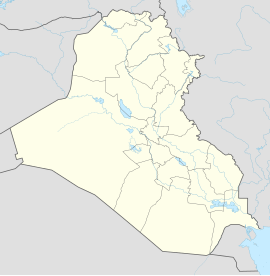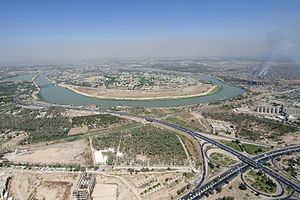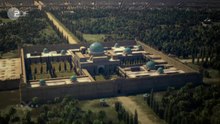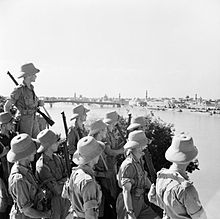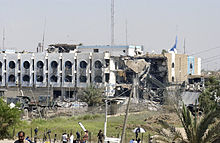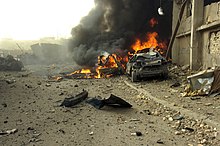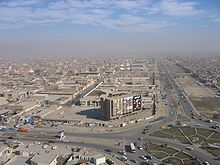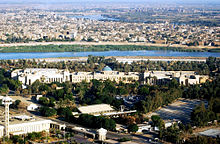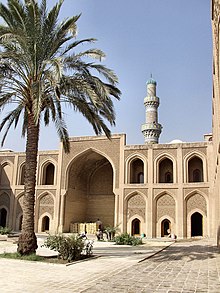Baghdad
| Baghdad | ||
|---|---|---|
| location | ||
|
|
||
| Coordinates | 33 ° 20 ' N , 44 ° 23' E | |
| Country |
|
|
| Governorate | Baghdad | |
| Basic data | ||
| height | 40 m | |
| surface | 204.2 km² | |
| Residents | 5,402,000 (January 1, 2010) | |
| Population density | 26,454.5 inhabitants / km² | |
| prefix | 1 (city), 964 (country) | |
| Post Code | 10001-10090 | |
| mayor | Zekra Mohammed Alush | |
| City map of Baghdad | ||
Baghdad ( Arabic بغداد Baghdad , DMG Baġdād , Kurdish بەغدا Beẍda , from Persian “gift of the Lord” or “God's gift”, correspondingly baġ “God, Lord” and dād “gift”) is the capital of Iraq and the governorate of the same name . With 5.4 million inhabitants (2010) it is one of the largest cities in the Middle East . The metropolitan region , which extends far beyond the borders of the governorate, has 11.8 million people (2010), which corresponds to around 40 percent of the total population of Iraq .
The city is the political, economic and cultural center of the country and the seat of the Iraqi government, parliament , all state and religious central authorities and numerous diplomatic missions. Baghdad is the most important transport hub in Iraq and has numerous universities, colleges, theaters, museums and monuments.
geography
Geographical location
The Iraqi capital lies roughly in the middle of the country on average 40 meters above sea level . It extends along the middle reaches of the Tigris , which is navigable to Baghdad.
The river divides the city in half, the eastern part Risafa and the western part Karch . The bottom is very shallow and, due to the periodic flooding, of alluvial origin.
The Tigris River, on the banks of which Baghdad lies, is an important trade route for the city. In Baghdad, some leading trade routes converge through the fertile crescent moon , a winter rain area with high levels of precipitation , north of the Syrian desert and north of the Arabian Peninsula .
Together with the Euphrates , the Tigris, whose catchment area covers 375,000 square kilometers, forms the Mesopotamian region in which some of the first advanced civilizations developed.
City structure
Baghdad is divided into nine districts:
- al-Azamiyah (الأعظمية)
- Baghdād al-Jadīda (بغداد الجديدة, "New Baghdad") or Tisa Nisan ("nine Nisan ")
- al-Kāzimiyya (الكاظمية)
- al-Karrāda (الكرادة)
- al-Karch (الكرخ)
- al-Mansour (منصور)
- ar-Rashīd (الرشيد)
- ar-Rusāfa (الرصافة)
- ath-thaura (الثورة)
The city districts are divided into 89 districts.
The predominantly Shiite districts and districts in 2013 included Baghdād al-Jadīda, Habibiya, Sabaa al-Bour, Kazimiyah, al-Schaab (three districts), Ur, Schula and Sadr City; Jamia and Ghazaliya are predominantly Sunni.
climate
The city has a dry subtropical climate and is one of the hottest cities in the world in terms of maximum temperatures. In the summer months between June and September, the average maximum temperature rises to 41 to 49 degrees Celsius, accompanied by strong solar radiation: rain is extremely unlikely during this time of year. Temperatures above 50 degrees Celsius are not unknown, and even at night they rarely drop below 24 degrees Celsius.
The humidity is very low and is usually below ten percent. Dust storms from the deserts to the west are a normal occurrence in summer. They take place on an average of 20 days a year.
In winter, between December and February, the maximum temperature averages 16 to 18 degrees Celsius. The minimum temperature in January is around four degrees Celsius on average, but values below zero degrees Celsius are not uncommon at this time of year. The average annual rainfall of around 148 millimeters falls almost exclusively in the period from November to March.
| Baghdad | ||||||||||||||||||||||||||||||||||||||||||||||||
|---|---|---|---|---|---|---|---|---|---|---|---|---|---|---|---|---|---|---|---|---|---|---|---|---|---|---|---|---|---|---|---|---|---|---|---|---|---|---|---|---|---|---|---|---|---|---|---|---|
| Climate diagram | ||||||||||||||||||||||||||||||||||||||||||||||||
| ||||||||||||||||||||||||||||||||||||||||||||||||
|
Average monthly temperatures and rainfall for Baghdad
Source: Stadtklima.de; wetterkontor.de
|
|||||||||||||||||||||||||||||||||||||||||||||||||||||||||||||||||||||||||||||||||||||||||||||||||||||||||||||||||||||||||||||||||||||||||||||||||||||||||||||||||||||
history
City foundation and heyday
Baghdad was founded on July 30th, 762 as Madīnat as-Salām ("City of Peace") by the Abbasid al-Mansur as the new capital of the caliphate . It was created just a few kilometers east of the old capital of the Sassanid Empire , Seleukia-Ctesiphon . The Caliph's Palace ( Bāb adh-dhahab or Qubbāt al-ḫaḍrā ) and the main mosque on the western bank of the Tigris were built within four years . The city was designed to be circular with the palace and mosque in the center. The district town was divided into four quarters, each with a city gate pointing in one direction. Whether the “ Round City of Baghdad ” is a founding myth or a historical reality is still discussed. The caliph's soldiers were quartered in their own place (al-Harbiya) northwest of Baghdad. Today's Karch district was intended for the workers, while the court, the guard, the harem and the top administration lived within the district.
Due to the favorable location at the junction of numerous trade routes and the fertile cultivation areas thanks to the proximity to the Tigris ( Didschla ), the newly founded city flourished quickly. When al-Mansur's son al-Mahdi ascended the throne, Baghdad already had an area of 15 square kilometers. It was the center of science and the arts; in short: it was the heyday of Baghdad.
The House of Wisdom next to the Abbasid Palace was a kind of academy founded by al-Ma'mūn in 825 . The much older academy in Gundischapur served as a model . In the House of Wisdom, people worked on scientific translations, mainly from Greek into Arabic. In addition to the translation center, the complex also included an observatory , an academy and a rich library, as well as a hospital.
Stagnation and invasions
In the meantime, the caliph al-Mu'tasim bi-'llāh moved the capital to Samarra (808-819 and 836-892) to keep his army away from the population. But even when the Arab caliphs had lost their worldly power and first the Iranian Buyid dynasty (945-1055) and later the Oghuz Turks from the Seljuq tribe (1055-1135) ruled the Islamic caliphate, it remained one of the most important cities of the Islamic caliphate World until it was conquered by the Mongols under Hülegü after a short siege in 1258 . The Mongols killed the last caliph al-Musta'sim bi-'llah in February 1258 and, according to eyewitness reports, caused unimaginable atrocities; Sources report a pyramid made of skulls.
Much more important, however, was that in connection with this conquest of Baghdad and Mesopotamia, both the defending Mamelukes and the Mongols destroyed the country's highly complex irrigation systems. The consequences of this destruction were exacerbated by the displacement of the local population and the associated loss of knowledge about the operation and maintenance of the irrigation system. The desertification of Mesopotamia set in, and Baghdad, previously the second largest city in the world, sank into insignificance along with all of Mesopotamia.
In 1401 Baghdad was stormed again and sacked by Timur Lenk .
Ottoman rule
Since the 16th century, the rulers of Persia and Turkey fought over the city several times. In 1508 Baghdad came under Persian rule, and in 1534 the city was incorporated into the Ottoman Empire. In 1623 Persian troops recaptured the city, which was then taken again by the Ottoman forces in 1638. In 1652 Baghdad only had about 15,000 inhabitants. Baghdad remained under Ottoman rule and became the capital of Baghdad Province, one of the three provinces that later became Iraq.
After pashas in Basra and Baghdad had made themselves temporarily independent of the Ottomans in the 17th century, Hasan Pasha (1704–1723), appointed by the Ottomans as governor, established the power of the Mamelukes in Baghdad in 1704. The pashas of Baghdad subsequently gained extensive autonomy, but had to continue to recognize the suzerainty of the Ottomans. Under Ahmad Pascha (1723-1747) an attack by the Persians under Nadir Shah on Baghdad was repelled in 1733 . After Ahmad Pascha's death, the Ottomans tried to regain control of Baghdad, but in 1749 had to recognize Sulaiman Pascha (1749–1762) as governor. Under him the province of Basra was united with Baghdad.
Under Büyük Süleyman Pascha (1780–1802) the dynasty reached its climax when the country was pacified and extensive construction work began. An attack by the Wahhabis on Iraq was also successfully repelled in 1801 , although they succeeded in destroying the Shiite shrines Najaf and Kerbala . In 1831 Baghdad was occupied by Ottoman troops and returned to central administration after a plague epidemic had weakened the rule of the dynasty. In Baghdad, of the 80,000 inhabitants, only 27,000 survived.
In 1864 the first school of the Alliance Israélite Universelle was founded , with the aim of spreading progressive knowledge within the Jewish religious community. The Ottoman constitution of 1876 proclaimed Islam as the state religion, but gave the Jewish and Christian population equal political rights and gave them access to public office. At the time, Baghdad was a cosmopolitan and multinational city. Shiites and Sunnis were represented in fairly equal numbers among the Muslims; next to them there were many Jews who belonged to the wealthiest merchants and business people (around 1300 families with three synagogues ), Christians ( Armenians , Jacobites, Nestorians , Greeks, around 300 families). Persians and Indians were well represented. On June 2, 1914, the city gained a connection to the Baghdad Railway with the opening of the Sumike – Baghdad section .
British colonial times
British troops marched in during the First World War and occupied Baghdad on March 11, 1917 without major resistance from the Ottoman army. The British Commander General Sir Frederick Stanley Maude said in a statement on March 19, 1917 to the residents of Baghdad:
“Our armies do not come into your cities and your country as conquerors or as enemies, but as liberators. Residents of Baghdad, don't forget: for 26 generations you have suffered from foreign tyrants who did everything to ensure that one Arab house stood against another so that they could benefit from your disagreement. This policy is abhorrent to Britain and its allies, for there can be neither peace nor prosperity where there is enmity or bad government. "
After the suppression of a nationwide anti-colonial uprising by British and Indian soldiers under Lieutenant General Sir Aylmer Haldane , in the course of which numerous people were killed, Great Britain detached the provinces of Baghdad, Mosul and Basra from the Ottoman Empire in the autumn of 1920 and united them into the present day Iraq. The League of Nations sanctioned this measure and gave Great Britain the mandate over this newly formed country.
On August 23, 1921, the Kingdom of Iraq was established under British control, with Baghdad as its capital. On October 3, 1932, the British mandate was lifted and Iraq gained formal independence. The British, however, secured a special economic position and retained strong political influence.
Independence and economic boom
There was great resistance among the Iraqi people to Britain's strong role. With the support of Germany , officers eliminated the pro-British government in a military coup on April 1, 1941 . The new Prime Minister was Raschid Ali al-Gailani , who formed a "government of national defense". Great Britain sent troops from Transjordan and British India , which landed in Basra on May 2, 1941 . Although the Iraqi forces blew up the dams of the Euphrates , they were unable to stop the British advance. On May 29, 1941, after heavy fighting with the Iraqi army, British troops reached the suburbs of Baghdad and the Gailani government fled to Iran.
On June 1 and 2, 1941, a wave of Arab nationalist pogroms broke out against the local Jewish population. In the two days, 179 people of Jewish faith died in Baghdad, and numerous houses and shops in the Jewish quarter were destroyed. The British units remained on the outskirts and did nothing. In 1951 and 1952, almost all Baghdad Jews left Iraq for Israel via an airlift .
The population of the city rose from an estimated 145,000 (1900) to 490,000 (1957), mainly due to immigrants from the Shiite south who, when they arrived in the capital, suffered from severe housing shortages. It was only under the rule of Abd al-Karim Qasim that something remedied was provided by the construction of the then almost exemplary satellite city of Madinat al-Thaura (“City of Revolution”), later Saddam City, then Sadr City .
After the nationalization of companies in the oil sector in 1972 and the rise in the price of oil from 1973 onwards, Iraqi oil revenues were enormous. At this time a modern infrastructure with sewers, water pipes and highways was built. A lot of money was also used in social policy measures, especially in the development of the health and education sectors.
The oil revenues were also used to boost industry, transportation and communications and other areas such as recreation, tourism, commerce and all other economic sectors. During this time the population continued to grow rapidly. The majority of the immigrants were Shiite Arabs. Most of them moved to the suburbs of Baghdad, where they lived in slums under the most precarious conditions.
First and Second Gulf War
During the First Gulf War (1980–1988) between Iran and Iraq, the city was the target of Iranian R-17 rocket attacks , which, however, claimed few casualties and caused little damage. During the Second Gulf War , the city was bombed for seven weeks from January 17, 1991 by the Allied forces under the leadership of the USA.
The aerial warfare was aimed at military targets such as the Iraqi Republican Guard , air defense systems, military aircraft and airfields, and spy systems. At the same time, it aimed at facilities that could be useful to both the military and civilians: electricity, communications, oil refineries and pipelines, railways and bridges. The capital's energy supply was destroyed. At the end of the war, electricity production was four percent of the pre-war level, and months later it was 20 to 25 percent.
Furthermore, the drinking water supply was deliberately destroyed over a large area, which in particular caused severe suffering to the civilian population. Bombs destroyed the control systems of most pumping stations and numerous sewage treatment plants. The wastewater flowed directly into the Tigris, from which the civilian population of the Iraqi capital had to take drinking water. This caused epidemics in the city .
In most cases, the allies avoided attacking purely civilian targets. However, more than 300 civilians were killed in bombing during an air raid on an air raid shelter on February 13, 1991 in Baghdad. The US government stated that the bunker was a legitimate military target and regretted the loss of life.
Iraq war
The Iraq war began on March 20, 2003 with targeted bombing in Baghdad. On the night of March 19-20, 2003, two hours after the ultimatum had expired, the United States fired 40 cruise missiles at the capital. The declared aim was to overthrow Saddam Hussein and to locate weapons of mass destruction. The bombing of the Allied forces led to considerable destruction of the military and civil infrastructure.
In the first two days of the war, US troops penetrated about 200 kilometers inland; on March 24, the troops were already 90 kilometers from Baghdad. After about ten days this advance came to a standstill. There were several reasons for this: On the one hand, a very violent sandstorm that put weapon systems such as helicopters at great risk, resistance from Iraqi troops who tried to protect critical passages across the Euphrates , and the rapid initial advance that left a long supply line relatively unsecured. But then the Iraqi resistance (not the militia) quickly collapsed.
In the early morning hours of April 3, 2003, the battle for Baghdad began with an intensive bombardment of "Saddam International Airport" . The city's airport was captured on April 4th. On April 5, US troops advanced into the city center for the first time. Although there was no house-to-house fighting , as had been feared, the Iraqi side suffered heavy losses. The armed forces of Iraq limited themselves to a largely passive approach with many defensive structures such as trenches and paramilitary activities. From this point on, Baghdad could still be considered an open city. US forces took the city largely under their control over the next four days, after which there has been continued minor fighting.
On the afternoon of April 9, 2003, American M1A1 Abrams main battle tanks were standing on Firdausplatz (Paradise Square) in front of the Palestine Hotel . At 6:49 p.m., a US soldier covered the Saddam statue first with the US flag and later with an Iraqi flag. The statue was then brought down with the help of an M88 armored recovery vehicle . This picture symbolizes the end of the Iraq war.
US occupation from 2003 to 2009

After the fighting ended, all of Baghdad suffered from looting and chaos, which the US forces could not control. On May 1, 2003, US President George W. Bush declared the Iraq war over. Nevertheless, there were repeated devastating attacks that affected not only US troops but also the Iraqi population.
An attack on the UN headquarters in Baghdad on August 19, 2003 claimed 23 lives, including the UN special envoy Sérgio Vieira de Mello .
On August 31, 2005, a mass panic broke out among Shiite pilgrims on the Al-Aaimmah Bridge , which spans the Tigris and connects the districts of Asamya and Kasamiya, commemorating the death of Imam Mussa Al-Kadhim. The rumor that a suicide bomber was in the crowd caused panic, as a result of which hundreds of people were crushed and trampled or fell into the Tigris; 1,011 people were killed and more than 800 injured in the accident. Due to this incident, a three-day state mourning was ordered.
On September 14, 2005, a car bomb exploded amid a group of job seekers, killing 112 people and injuring dozens. On August 28, 2006, 13 people died in an attack on the Ministry of the Interior. The attack was aimed at the police chiefs of all 18 governorates in the country who were in the building in the Iraqi capital. On November 23, 2006, 202 people were killed and 255 injured in the almost simultaneous explosion of six car bombs in the Sadr City district. On February 3, 2007, a suicide bomber detonated a truck loaded with explosives in the middle of a busy market, killing 137 people and injuring more than 300.

On April 12, 2007, an explosion shook the parliament building in the heavily secured “Green Zone” in Baghdad. According to the first press reports, at least two MPs were killed. A few hours earlier, an important Tigris bridge in Baghdad, the Al-Sarafija Bridge , had already been destroyed in a suicide attack, which also killed several people . A few days later, on April 18, 2007, five more attacks hit the Iraqi capital. The detonation of a car bomb near the market square in the Sadrija district alone killed 127 people. In total, the attacks claimed more than 230 lives. In an air raid on a district of Baghdad on July 12, 2007 , gunmen of US Apache helicopters killed 12 civilians, including the two Reuters employees Saeed Chmagh and Namir Noor-Eldeen.
Since the official end of the Iraq war in May 2003, considerably more US soldiers have been killed in attacks by both resistance groups and Islamist terrorists than in the war. The attacks also claimed numerous victims among the civilian population. Representatives of the Iraqi government, which is largely supported by Shiites and Kurds, have also repeatedly been the target of attacks. The terrorist group al-Qaeda is apparently pursuing the strategy of provoking a civil war between Shiites and Sunnis in order to prevent Iraq from finding a state. The capital Baghdad in particular is affected by the clashes. Most of the dead there also showed signs of torture.
In 2003, the US Army began building protective walls up to five meters high to protect important buildings from terrorist attacks. Later, the US Army shielded entire districts with concrete walls. In order to bring the continuing violence under control, the government began planning an even larger structure in 2006, the 100-kilometer Baghdad barrier belt . It was to be built in the form of a ring of water-filled trenches secured with barbed wire, as well as barriers, fences and reinforced checkpoints around the capital. The building was never realized after the violence had subsided.
On June 30, 2009, US forces withdrew from Baghdad and other cities. They were moved to bases outside the cities. The Iraqi government declared the day a national holiday of sovereignty. On August 5, 2009, Prime Minister Nuri al-Maliki decided to tear down all of the protective walls in the capital. Numerous attacks have continued since the US Army withdrew from Baghdad. On August 19, 2009, more than 100 people were killed in bomb attacks on the Ministry of Finance and the Ministry of Foreign Affairs. On October 25, 2009, 155 people died when two car bombs detonated at the Justice Department and the Governor's seat. On December 8, 2009, a series of attacks on the Home Office, the Ministry of Labor, an art institute and a courthouse left 127 people dead. On April 4, 2010, 50 people died in a series of attacks on foreign embassies, including the German one.
population
Population development
Due to the high birth rate and the strong rural exodus , the population of Baghdad grew very rapidly, especially in the second half of the 20th century. In 1947 only 352,000 people lived in the city, by 1965 there were already 1.5 million. By 1977 this number had doubled to 2.9 million. In 2010 the city had 5.4 million inhabitants.
Due to the narrow city limits, the population increase in the city has meanwhile been significantly weakened. This is mainly taking place in the numerous suburbs, which are now more populous than the city itself with around 6.4 million inhabitants. In the metropolitan region of Baghdad there are a total of 11, 8 million people (2010). A population of over 15 million people is expected in the agglomeration in 2050 and over 34 million in 2100.
The vast majority of the population is of Arab descent (this is divided into the religious groups of Sunnis and Shiites ), but there is also a large Kurdish community, as well as a significant number of Turkmen , Assyrians / Arameans . Some Sudanese also inhabit the metropolis.
The population figures in the following overview refer to the actual city without the suburban belt.
| year | Residents | year | Residents | |
|---|---|---|---|---|
| 1800 | 80,000 | 1935 | 287,000 | |
| 1860 | 105,000 | 1947 | 352,000 | |
| 1870 | 100,000 | 1957 | 490.496 | |
| 1880 | 60,000 | 1965 | 1,523,302 | |
| 1885 | 180,000 | 1977 | 2,888,000 | |
| 1890 | 145,000 | 1981 | 3,300,000 | |
| 1900 | 145,000 | 1987 | 3,841,268 | |
| 1910 | 225,000 | 1995 | 4,478,000 | |
| 1920 | 250,000 | 2008 | 5,258,000 | |
| 1930 | 250,000 | 2010 | 5,402,000 |
languages
Iraqi Arabic , a dialect of Arabic, is spoken in the capital . Whenever “standard Iraqi Arabic” is mentioned, the Baghdad dialect is almost always meant. This can be divided into an “Arabic” ( gilit ) and a “Judean” ( Keltu ) branch according to the pronunciation of high Arabic qultu (“I said”) . Standard Arabic has been a written language since the Arab conquest in the 7th century.
The members of the Chaldean Catholic Church celebrate the liturgy in the Syriac Aramaic language . However, since the majority of the faithful speak Arabic, the Arabic colloquial language of the population is increasingly being used when reading prayers, Bible passages and some liturgical formulas, and Holy Mass is often bilingual. Religious instruction is in Arabic.
The liturgical language of the Armenian Catholic Church is Armenian. The language of the Assyrian Church of the East is Syriac , which belongs to Aramaic . The use of modern languages in worship is controversial. The Syriac Orthodox Church uses the West Syrian liturgy of Antioch . The Kurdish minority speaks Kurmanji , Sorani and South Kurdish . The most common written Kurdish language is Sorani. English is widely used as a foreign language, and French and in some cases German among the upper classes of Baghdad .
Religions
Muslims
The situation in the Iraqi capital after the fall of Saddam Hussein in March 2003 is complex: the emergence of new political groups, the reawakening of traditional religious movements and the birth of new formations, the return of religious leaders living in exile and the influence of the neighboring countries created a framework against the background of which political and religious authorities often overlap and inside each group wants to secure its own place in the future Baghdad.
The growing tensions led to terrorist attacks and expulsions of Sunnis and Shiites against each other. Since the “ ethnic cleansing ” has largely been completed, violence between religious groups also decreased in 2007. One reason for this is that there are hardly any heterogeneous city districts, so attacks require more complex planning. Another reason for the decreased violence is the US army's barriers that separate Shiites and Sunnis.
95 percent of the population are Muslims . Accordingly, there are many mosques in Baghdad , the most famous of which is the Abu Hanifa Mosque . Before the 2003 invasion, 65 percent of Muslims were Sunnis and 35 percent Shiites. As a result of the displacement of the Sunni population, their proportion fell to 20 to 25 percent by 2007, the proportion of Shiites increased accordingly to 75 to 80 percent.
Christians
During the reign of Saddam Hussein, religious freedom had a relatively high level; the government in Baghdad also included Christian ministers such as the Chaldean Catholic Tariq Aziz . About half of the Christians in Iraq live in Baghdad. Their share of the total population was around ten percent by March 2003, but fell to around five percent by 2006 because of the crisis in Iraq. Traditional settlement centers of the Christians of Baghdad were initially in Aqd an-Nasara ("quarter of the Christians") on the east bank of the Tigris in the district of ar-Rusāfa , later in particular in al- Karrada in the district of the same name east of the Tigris and in Dora in the district of ar-Raschīd to the west of the Tigris. Around the year 2000, around 150,000 Christians lived in Dora , the majority of whom were members of the Assyrian Church of the East and the Chaldean Catholic Church . After the “ religious cleansing ” by al-Qaida , there were around 1,500.
The political tensions between Sunnis and Shiites did not offer Christians any secure prospects. According to the auxiliary bishop in Baghdad, Andreas Abouna , around 75 percent of the Christian population have left the capital since the beginning of the war to seek refuge in the Kurdish north of Iraq or the neighboring states of Turkey, Syria and Jordan.
The Patriarchate of Babylon , based in Baghdad, is the ecclesiastical form of organization of the Chaldean Catholic Church. It continues the early church Catholic of Seleukia-Ctesiphon . The Patriarchate of Babylon is the largest Christian church in Iraq with about 63 percent. The seat of the Patriarchate was moved in 1956 from the old Mater Dolorosa Cathedral to the new Chaldean Cathedral of St. Joseph .
The region's Roman Catholic Church is organized in the Archdiocese of Baghdad . It was elevated to a diocese on September 6, 1632 and an immediate archdiocese on August 19, 1848 . Their long-standing cathedral was the St. Joseph Church , but in 1984 the new Cathedral of St. Joseph and St. Teresa of the Infant Jesus took over this role. The Archparchy of Baghdad with the Cathedral of Our Lady of Nareg is an archdiocese of the Armenian Catholic Church united with the Roman Catholic Church. Founded on June 29, 1954, the Archeparchy has no suffragans . The Syrian Catholic Church has the Sayidat al-Nejat Cathedral of the Archeparchy of Baghdad in Baghdad . This was the target of a devastating terrorist attack on October 31, 2010 , but was able to reopen. The Melkite Greek Catholic Church in the Patriarchal Exarchate of Iraq with the Cathedral of Saints George and Nicholas is only a small community .
Baghdad is the historic seat of the Patriarch of the Assyrian Church of the East . After the Assyrian schism in 1964, the Old Church of the East inaugurated its Patriarchal Cathedral of the Virgin Mary here in 1984 , while the Assyrian Church of the East, among other things, kept the Gewargis Church in Dora. The bishops of the Syrian Orthodox Church , previously organized in the local area as the “ Maphrianat of the East”, have their seat in Baghdad, since 1964 in the Cathedral of St. Peter and Paul . Their relatives are often called Arameans , especially in the diaspora .
The Armenians of the Apostolic Church have had a very long presence in Baghdad . The small Miskinta Church was built in 1639/1640 and served as the Armenian Cathedral of Baghdad for centuries, until the new Cathedral of Saint Gregory the Illuminator took over this function in 1957 . The Greek Orthodox Church of Antioch has only a few hundred members and has its archbishopric for Baghdad and Kuwait in St. George's Cathedral .
Jews

The Jewish population, which once played an important economic, cultural and political role in public life, has almost completely left Iraq. From 1946 to 1949 there were repeated riots against Jews. When the government declared Zionism a capital crime on July 19, 1948 , 135,000 Jews lived in the country, 77,000 of them in Baghdad - a quarter of the total population.
On March 3, 1950, the Jewish population was allowed to leave the country, giving up Iraqi citizenship. A year later, on March 10, 1951, the government froze the emigrants' property and blocked their bank accounts. Until that day, they owned almost all the Suq of Chordja, the business district in central Baghdad. The Israeli government under David Ben-Gurion took this action as an opportunity to start the "Esra and Nehemiah" operation, with around 95 percent of Iraqi Jews being airlifted to Israel by 1952.
Economic restrictions were imposed on the 6,000 Jews remaining in Iraq. In 1958, their status as a Jewish community was revoked and community property was confiscated. In the following decades the rest of the Jews also left the country. In 1968 there were 2,500 Jews living in Iraq, in 1976 there were 400 and in 2001 only 100. On July 25, 2003, six of the last 34 Jews from Baghdad were flown to Israel.
politics
City government
Baghdad is ruled by the city council and the governor of the governorate of the same name , who is appointed by the Iraqi president. The governor is also the mayor of the Iraqi capital. The first city council after the invasion of the US troops was elected indirectly by all boroughs in July 2003, still under American guidance. The all-Iraqi body has 37 council members.
Sabir al-Isawi has been the mayor and governor of Baghdad since 2005. His predecessor in office, Ali al-Haidari , died on January 4, 2005 in an assassination attempt. Al Haidari was bombed in September 2004 and he survived. He was the highest-ranking official in Baghdad after former city council president Abdel Sahraa Othman was murdered in May 2004.
Town twinning
Baghdad has partnerships with the following cities:
Culture and sights
Music and theater
Baghdad has always played an important role in the country's cultural life. The capital is home to writers, musicians and visual artists, it attracts the most gifted artists of classical and modern music as well as dance and theater arts from all over the country.
The Iraqi National Orchestra, founded in 1959, is one of the most important cultural institutions. Rehearsals and performances were briefly interrupted during the 2003 Iraq war , but have since returned to normal. The 50-piece orchestra consists of musicians of various faiths, such as Shiites , Sunnis and Christians .
Theatrical troupes from Europe have been traveling to Baghdad since 1880 to play in front of mainly British audiences. Iraqi writers began to write plays in the 20th century. The major theaters in Baghdad are the Rasheed, the Mansour and the Folk Theater. The Iraqi National Theater was looted during the invasion, but was able to reopen after renovations . Plays by Iraqi, Indian, Turkish, Syrian and Egyptian authors are performed in the city's theaters. The program also includes the great dramas of world literature: Johann Wolfgang von Goethe , William Shakespeare , Bertolt Brecht , Jean Genet , Samuel Beckett , Albert Camus and Federico García Lorca .
Museums
Important museums are the National Museum , which reopened in April 2000 after a long period of renovation, and the only surviving city gate in Baghdad (now an arms museum).
In the wake of the conquest of Baghdad by the US armed forces in the Iraq war in 2003, numerous historically valuable cultural assets of the city were destroyed or damaged by fighting or looting; in particular, the national library fell victim to a fire, in which mainly archives from Saddam's Hussein reign were destroyed and the national museum was plundered. The incoming US troops did not intervene.
Some of the cultural assets that were initially missing and looted have reappeared since the war. The American authorities claim that they have seized many manuscripts and works of art from the National Museum in Baghdad. Other objects had been hidden by the Iraqi authorities in the basements of the National Museum or moved to other buildings (some of them as early as the second Gulf War) and survived the turmoil.
Buildings
The old town on the left side of the Tigris was redesigned with the construction of many high-rise buildings. The ruins of Bab al-Wastani, the Abbasid Palace (built in 1179), the Madrasa Mustansirijah (1227) and Marjan Mosque (1356) are among the few remaining structures .
The Abu Hanifa Mosque is the most famous Sunni mosque in Baghdad. It was built by the Ottomans during their over four hundred year rule in Iraq near Abu Hanifa's tomb, one of the founders of the Hanafi school of law. The al-Chadimijja Mosque in the northwestern part of the city of Baghdad is one of the most important Shiite shrines in the country. The mosque, completed around 1515, houses the graves of the seventh and ninth Imams.
The tallest structure in Iraq is the Baghdad TV Tower . It was built in reinforced concrete in 1994 and was originally called Saddam International Tower. The tower measures 205 meters from the ground to the top of the antenna (150 meters to the roof).
The modern city center, Karch, is located on the western side of the Tigris. Several bridges, rebuilt after the bombing in 1991, connect it to the historic city center of Rusafah. In Karch, most of the ministries and the main train station are located between high residential buildings.
The highly secured government district is located in the so-called "green zone". The coalition interim administration had its seat here since March 2003. This was the main instrument of administrative work in Iraq, which was occupied by coalition troops after the Iraq war. On July 28, 2004, the newly formed Iraqi interim government was entrusted with the performance of these tasks. In the ten square kilometer area, cordoned off by walls and barricades, the Iraqi parliament and several ministries, most embassies, palace buildings, villas and gardens are located. Near the Republican Palace are three ten meter high bronze sculptures of Saddam Hussein . One kilometer from the Ministry of Information is the Rasheed Hotel, from where the CNN news channel reported the start of Operation Desert Storm on January 17, 1991 .
Monuments such as the Al-Shahid Monument , the Tomb of the Unknown Soldier and the triumphal arch " Swords of Kadesia " in the form of two crossed swords are dedicated to the memory of the First Gulf War. The double triumphal arch is named "Swords of Kadesia", which is dedicated to the battle of Kadesia , when the Arabs defeated the Persians around 636 AD. The 24-ton blades were built from melted down rifles and tanks from killed Iraqi soldiers. Iranian helmets with bullet holes decorate the base. The fists are replicas of Saddam Hussein's own hands.
A few kilometers north of the Iraqi capital is the suburb of Kadhimain with the Golden Mosque. With the tombs of the fifth and sixth Shiite imams, the mosque became an important place of pilgrimage.
Parks
The zoo in Baghdad was the largest zoo in the Middle East until the 2003 invasion with 650 to 700 animals. Iraqi units and US troops had fought heavy fighting on the site. The Allied bombing and looting by the population only survived 35 animals. The animals were shot, stolen and eaten, and some died because they were left without food and water for days. The zookeepers had fled when the air raids began and left the animals without care.
Escaped animals were later recaptured or bought back at the local market. Animal rights activists and the military rebuilt the zoo. In addition to the lions, the main attractions are rare bird species, some eagles, owls and peacocks. There is also an artificial lake where boat trips can be taken.
The Lunapark is not far from the zoo. The amusement park has a small ferris wheel and play facilities for children. The park with a lake in the Jadrija district, near the University of Baghdad, is also popular with the population .
Sports
Football is the most popular sport in Iraq. The Iraqi First League is very popular. The league was introduced in 1948, but discontinued between 1949 and 1962. In 1962 game operations were resumed. However, until 1973 only teams from Baghdad participated; only from 1973 this was possible for teams from all over the country. Due to the Iraq war, the league was suspended between 2002 and 2004.
Baghdad is home to some of the most successful football teams in Iraq. The most successful capital city club is Al-Zawraa with eleven national championship titles . The team plays their home games in the Al-Zawraa Stadium (capacity: 8,000 spectators). The home ground of the seven-time national champions Al-Quwa al-Jawiya (Air Force) is the Al-Shaab Stadium , which opened in 1966 . It is the largest stadium in Baghdad with a capacity for 45,000 spectators. Another much larger stadium is still in the construction phase. The five-time national champion Al-Talaba ("the students") plays his home games in the Al-Talaba Stadium (capacity: 10,000 spectators). The home ground of the two-time national champions Al-Shorta (police) is the 7,000-seat Al-Shorta Stadium.
The city also has a long tradition in equestrian sports. The first horse races took place shortly after the British took the city in 1917. But there are also reports of pressure from Islamists to end this tradition because of the gambling involved. Other sports such as weightlifting, martial arts, futsal , basketball and swimming are also popular.
gastronomy
Baghdad specialties include khouzi, a reduced version of the traditional Arabic feast, stuffed lamb, and masgoof, a fish grilled over an open fire. Although there are many different types of freshwater fish in the Tigris , the most popular fish for Masgoof is the shabboot, but booni and theka are also popular.
The basic food of the population is made up of wheat (as bread grain and especially in the form of wheat semolina, couscous or bulgur ), millet, dates (the bread of the desert), various types of vegetables (often filled, as a stew or pickled) and legumes. Goats, sheep, chickens, and less often cattle and camels meet the demand for animal food. In addition, the spice trade and the Islamic dietary regulations were particularly influential, even if the latter are not binding on the religious minorities .
In Baghdad, specialized areas of food production emerged early on, which were therefore outsourced from households, for example for bread and baked goods. The bread (in many forms) is an integral part of every meal. It is almost always broken into pieces instead of being cut. It is also used to hold food or as a basis for desserts such as Om Ali , a popular sweet pastry with different layers of dates, pistachios and raisins.
Economy and Infrastructure
economy
Baghdad is the country's industrial center, home to the textile, wood, building materials and food industries as well as oil refining, among other things. The Iraq Stock Exchange , which opened on June 24, 2004, and the state-owned oil company Iraq National Oil, founded in 1966, are also based in the Iraqi capital.
Agriculture in the surrounding area mainly produces dates and vegetables .
After all foreign oil companies were nationalized in 1972 and the oil crisis led to a rapid rise in oil prices, there was an economic boom in Baghdad from the mid-1970s. A large part of the population also benefited from this rapid development. The two Gulf Wars (1980–1988 and 1990/1991) as well as the consequences of the UN embargo (1991–2003) caused great damage to the country's economy. The standard of living deteriorated drastically, particularly due to the embargo in the 1990s.
Problems are caused by the inadequate infrastructure and the extremely large housing shortage. Hundreds of thousands of people lost their homes because of the devastation in the Iraq war in 2003 and the ensuing fighting between Shiites and Sunnis who displaced each other from their homes. Many of the homeless in Baghdad come from Kirkuk Governorate , where they have been driven from their homes by returning Kurds ; still others were left homeless because they had no money to pay the high rents.
In the industry, which is concentrated in the capital region, there are only inadequate disposal and cleaning capacities for sewage, exhaust gas and waste. In addition to the numerous infectious diseases that are spread due to inadequate hygienic conditions, there are respiratory and skin diseases due to the toxic emissions from numerous industrial companies and car traffic.
In a study by the consulting firm Mercer on the quality of life in 231 cities around the world, Baghdad came in last. (Status: 2018)
traffic
Long-distance transport
The Iraqi capital is the junction of all highways from east to west and from north to south. The main routes lead from Baghdad in a northerly direction to Kirkuk , Erbil , Ninive and Zaxo ; in a westerly direction towards the Jordanian border; in an easterly direction to Chanaqin (Iranian border); and in a southerly direction to Hilla and Kerbela and to Basra and Safwan (Kuwaiti border). Highways connect Baghdad with the capitals of all neighboring Arab countries. The city has motorway connections to Amman , Damascus , Kuwait City and Riyadh . There are regular bus connections between Baghdad and the major cities in the country.
The Baghdad station is the intersection of the three main railway lines in the country, by the state Iraqi Republic Railways operate. Part of the rail network is currently out of order. The railway is mainly used by the low-income population. The reliability of the railroad is so low that arrival times are not even given. A journey of over a day from the Iraqi capital to the southern Iraqi metropolis of Basra, which is about 550 kilometers away, is not unusual. Baghdad Railway Station was once the terminus of the Baghdad Railway . Between 1940 and 1972 a continuous train ran to Istanbul .
Of the four airports in Baghdad and the surrounding area, only one is used for civil purposes. The Baghdad airport (until 2003 Saddam International Airport ) is the largest airport in the country, which was built between 1979 and 1982 by French companies. At full capacity, the airport can handle 7.5 million people annually. Baghdad International Airport replaced Al-Muthanna-Airport, which had functioned as an international airport since the 1950s. It was rarely used between 1991 and 2003. US troops captured the airfield in April 2003, and regular flights have been taking place again since 2004. With Iraqi Airways , the national airline of Iraq, national flights are possible.
Local transport

With the exception of the city center, the city's road network appears largely planned. After the invasion of the US troops, the number of passenger cars increased rapidly, which not only overloaded the streets of Baghdad, but also made it extremely dangerous. This is compounded by the lack of public transport.
The city does not have a high-capacity, high-capacity public transport system, such as a subway , light rail or tram , that would relieve the street. Local public transport is handled by diesel-powered buses, private minibuses and shared taxis that share the lanes with private transport.
The first horse-drawn tram opened in 1871. The four-kilometer route to al-Kazimiyya was in operation until 1941. Today the route is no longer visible.
The Saddam Hussein government planned a subway for Baghdad in the 1970s . For this purpose, the Baghdad Rapid Transit Authority (BRTA) was founded in 1980, which should be responsible for planning, construction and ultimately also for operation. Three lines were planned:
- Line 1: Taura-Aadamijja, 18 kilometers in length, with 20 stations
- Line 2: Mansour-Masba, 13 kilometers with 17 stations
- Line 3: In the north of the Iraqi capital
The first line, of which six kilometers with seven stations were under construction, was originally supposed to open in four stages in 1987 and 1988. Due to economic problems after the Second Gulf War in 1991, the project was not implemented. In 2009 the city government called on foreign companies to apply to build the Baghdad Metro. However, due to the high costs, it is unlikely that the project will be realized anytime soon.
media
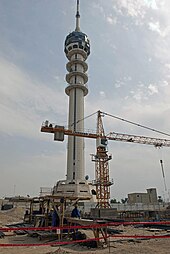
Since the fall of Saddam Hussein in 2003 , there has been a great diversity of media in Iraq . Although the new Iraqi constitution guarantees freedom of the press , the country ranks 145th in the ranking of press freedom published by Reporters Without Borders. In general it can be said that in Baghdad a distinction has to be made between two types of media: the party-controlled and the independent. Every major party has its central body, and quite a few also maintain television channels.
The most important newspapers appearing in Baghdad are al-Sabaah, al-Mada, al-Mashriq and al-Dustur as well as the Islamist al-Mujahed, al-Shahed, Thaura Islamiyya. There is a vast number of radio stations in Baghdad. The largest radio stations based in the capital are Republic of Iraq Radio (successor to Iraq Media Network-Radio Baghdad and founded by the CPA ), the Voice of Iraq (a private broadcaster on medium wave) and Radio Dijla (a private talk and music broadcaster on FM).
Iraqi television began broadcasting in Baghdad in 1956. In the 1990s there were only three television channels: Iraq-TV, Al-Shabab TV (owned by Udai Hussein ) and Iraq Satellite TV. Satellite dishes were strictly prohibited. From 2003 onwards, a large number of television channels emerged and channels such as al-Jazeera and al-Arabiya are very popular. Some of the broadcasters based in Baghdad are: al-Iraqia (Iraqi state television), Al-Sharqiya (private), al-Hurra (US coalition broadcaster), al-Baghdadia (private), al-Sumeria (private), Al- Anbar ( SCIRI station ) and al-Moktadia (Islamist).
The number of Internet connections has increased rapidly since 2003. Many political parties also have their own websites. At the moment, however, Internet publications do not have any influence on the masses, the medium is used almost exclusively for communication. The young people often use the computers made available in the various youth centers. Broadband Internet access and wireless network connections are also available in Baghdad .
education
The Iraqi cities and especially Baghdad have a well-developed education system. Schooling is free, but the illiteracy rate is high. Baghdad is home to three of the country's six universities, Baghdad University , Al-Mustansiriyya University, and Baghdad Technical University .
Al-Mustansiriyya University was built in 1233 as an Islamic college and is one of the most important educational institutions in Iraq and the Middle East. It has been part of the six universities in Baghdad since 1962. Primarily law and literature are taught.
The University of Baghdad was completed in 1962 according to plans by Walter Gropius . A new university for scientists, engineers and liberal arts was to be built for a total of 6,800 students. The campus was expanded in 1982 to accommodate 20,000 students. The architects Hisham N. Ashkouri and Robert Owen developed the complete academic space organization for the entire campus.
The National Library of Baghdad fell victim to the flames on April 14, 2003 during the Iraq war. Centuries-old manuscripts and other historical documents from the time of the Ottoman Empire were destroyed.
sons and daughters of the town
Baghdad is the birthplace of numerous prominent personalities.
Others
Baghdad is the setting for numerous stories in the Arabian Nights (for example Aladin , Ali Baba and the 40 robbers ). The first film adaptation of the fairy tale from the Arabian Nights is " The Thief of Baghdad " by Raoul Walsh , an American silent film from 1924. It is also the setting for the Isnogud comic series , which can in part be understood as a parody of the stories from the Arabian Nights .
See also
- List of Islamic Art Centers
- On the history, city foundation and heyday: House of Wisdom
- List of cities in Iraq
- Umm al Qura mosque
literature
- Walter Laufenberg : I think of Baghdad at night - state guest on the evening before the start of the war. Edition Karo, Berlin 2012, ISBN 978-3-937881-38-6
- Matthew Bogdanos with William Patrick: The Thieves of Baghdad. Robbery and rescue of the world's oldest cultural treasures. From the American by Helmut Dierlamm (original edition: Thieves of Baghdad, Bloomsbury Publishing, New York 2005), Deutsche Verlags-Anstalt, Munich 2006, ISBN 3-421-04201-2
- Jean-Louis Dufour: Les crises internationales: De Pékin (1900) à Bagdad (2004) , ISBN 2-8048-0022-9
- Stephan Kloss: My Baghdad Diary. As a war reporter in Iraq. Fischer Taschenbuch, Frankfurt 2003, ISBN 3-596-16142-8
- Jacob Lassner: The Caliph's personal domain. The City Plan of Baghdad Re-Examined . IN: Hourani / Stern (ed.): The Islamic City. Oxford 1970.
- Jacob Lassner: The Topography of Baghdad in the Early Middle Ages. Text and Studies , Wayne State University Press, Detroit 1970.
- Christoph Reuter, Susanne Fischer: Café Bagdad. The immense everyday life in the new Iraq. Goldmann, Munich 2006, ISBN 3-442-15385-9
- Karin Rührdanz : The old Baghdad - capital of the caliphs , Urania-Verlag, Leipzig 1991. ISBN 3-332-00503-0
- Vincenzo Strika and Jabir Khalil: The islamic Architecture of Baghdad. The Results of a Joint Italian - Iraqi Survey , Naples 1987.
- Jean Benjamin Sleiman: Dans le piège irakien: Le cri du cœur de l'archevêque de Baghdad , ISBN 2-7509-0240-1
- Najem Wali : Baghdad. Memories of a cosmopolitan city , table of contents , translation from Arabic by Hartmut Fähndrich , Carl Hanser Verlag, Munich 2015, ISBN 978-3-446-24922-6
- Mona Yahia: A dark stream flows through Baghdad , dtv, Munich 2004. ISBN 3-423-20715-9
Web links
- Link catalog on Baghdad (English) at curlie.org (formerly DMOZ )
- Official website of the city government (Arabic)
- Goethe-Institut Dialogue Point German - Baghdad
- Interactive city map of Baghdad
- Tobias Mayer: The metropolis on the Tigris. Caliph Al-Mansur founded Baghdad 1250 years ago as the new capital of the Islamic Empire. Deutschlandfunk , accessed on July 30, 2012 (radio feature on the occasion of the 1250th anniversary).
References and comments
- ↑ a b c World Gazetteer: Page no longer available , search in web archives: population figures of the city
- ↑ This term is originally related to the Russian Bog (Бог = "God").
- ^ A Concise Pahlavi Dictionary. MacKenzie. Routledge Publications 2000
- ^ A b World Gazetteer: Page no longer available , search in web archives: population figures in the conurbation
- ↑ a b Humanitarianinfo.org: Baghdad - Districts and Neighborhoods ( Memento of March 6, 2009 in the Internet Archive )
- ↑ Iraq: Baghdad's Shia neighborhoods rocked by series of car bombs. The Guardian, Oct. 1, 2013
- ^ Mean climatic data Baghdad
- ↑ MJL Young, John Derek Latham, Robert Bertram Serjeant (editors): Religion, learning, and science in the ʻAbbasid period , p. 293, ISBN 0-521-32763-6
- ↑ Welt.de: This battle almost destroyed the Ottoman Empire
- ↑ Harpers.org: The proclamation of Baghdad 1917
- ^ Zvi Yehuda Shmuel Moreh (ed.): Al-Farhud. The 1941 pogrom in Iraq. Jerusalem 2010.
- ↑ UNHCR: Background information on the endangerment of members of religious minorities in Iraq (April 2005) ( Memento of January 21, 2013 in the Internet Archive ) (PDF; 108 kB)
- ↑ Hagalil.com: Iraqi Jews: With us in Baghdad
- ^ Die Welt: Rumsfeld: "A very good day" ( Memento from December 16, 2008 in the Internet Archive ), from April 11, 2003
- ^ Süddeutsche Zeitung: USA ask UN for help , August 21, 2003
- ↑ Der Spiegel: Many dead in an attack, attacks on US soldiers , August 28, 2006
- ↑ Der Spiegel: Bomb attack in the Iraqi parliament , April 12, 2007
- ↑ Die Welt: More than 230 dead in series of attacks in Iraq , April 18, 2007
- ^ Frankfurter Rundschau: Brutal US attack on journalists ( memento of April 8, 2010 in the Internet Archive ), April 5, 2010
- ↑ Iraq Body Count: The victims in the Iraq war
- ↑ Der Spiegel: Großer Graben to Pacify Baghdad , September 17, 2006
- ↑ iCasualties: Operation Iraqi Freedom ( Memento of October 17, 2015 in the Internet Archive )
- ↑ Focus: US troop withdrawal - cities again in Iraqi hands , from June 30, 2009
- ↑ Der Standard: Attacks on Sunday - number of victims increased to 155 , from October 27, 2009
- ↑ Der Spiegel: More than 120 dead in a series of attacks in Baghdad , December 8, 2009
- ↑ Der Stern: 50 dead from bombs outside embassies in Baghdad , April 4, 2010
- ↑ World 101 largest Cities. (PDF) Retrieved July 23, 2018 .
- ↑ Die Zeit: Progress in Baghdad? , dated December 3, 2007
- ^ Richard Spencer: The Telegraph: Iraq crisis: The Last Christians of Dora. Telegraph , December 22, 2014 ( in the web archive without paywall).
- ↑ Church in Need: Iraq: "Alarm Bell for Christianity" ( Memento of December 16, 2008 in the Internet Archive ), August 7, 2006
- ^ Zionismus.info: On the situation of the Jews in individual Arab states
- ↑ Governor of Baghdad shot dead. (No longer available online.) Tagesschau, January 5, 2005, archived from the original on December 16, 2008 ; accessed on November 23, 2015 .
- ^ FAZ: Tens of thousands of Iraqi cultural assets seized , from May 8, 2003
- ↑ Skyscraperpage.com: Baghdad TV Tower
- ↑ Heise.de: The Thumb of Power , March 13, 2006
- ↑ Umweltjournal.de: Animal welfare organization FOUR PAWS save animals from starvation ( Memento from December 16, 2008 in the Internet Archive ), from May 9, 2003
- ^ The daily newspaper: Peace Signs in Iraq - Baghdad Starts Again ( Memento of December 16, 2008 in the Internet Archive ), January 8, 2008
- ^ University of Kassel: Spiral of Violence , September 29, 2006
- ↑ Mercer's 2018 Quality of Living Rankings. Retrieved July 30, 2018 .
- ^ Tram views of Asia: Baghdad tram
- ↑ Clara.co.uk: Trams and metros in Iraq ( Memento June 7, 2007 in the Internet Archive )
- ^ Radio Free Europe: Baghdad Invited Bids To Build Metro
- ↑ Reporters Without Borders : Ranking list of press freedom 2009 ( Memento from February 1, 2011 in the Internet Archive )
